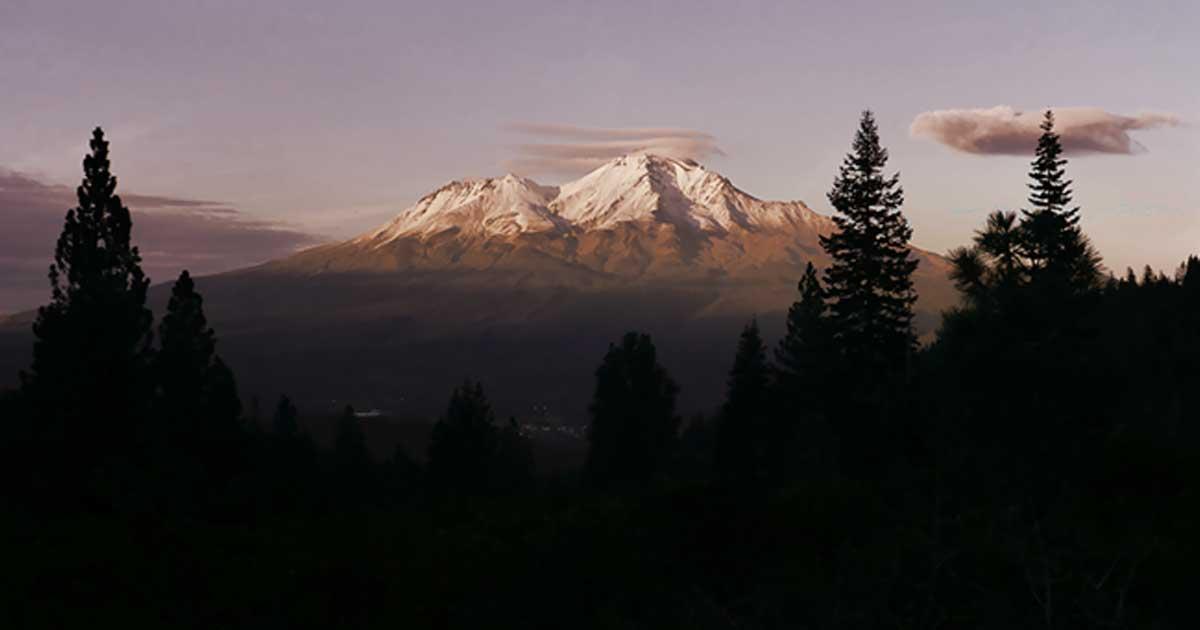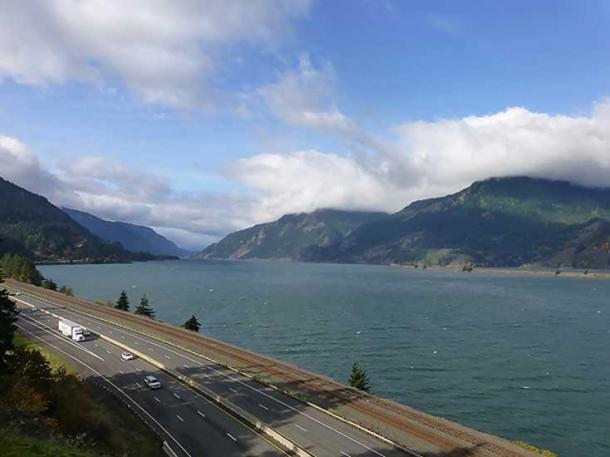
Cascadia: The Other “Lost Continent” – Part I
It was said that the end came without warning...
Once, long ago, as the people slept, the sun came out at night. It shot a flaming arrow across the heavens which burst into thousands of fragments, which then fell to the earth. The people were startled out of their sleep by a rumbling and quaking of the earth. The skies above them were on fire. The waters of the lakes and oceans rose. Soon the waves became mountains of water that rose against the shores. The sun was blotted out and darkness covered the great green land and water. Terrified, the people ran to the hills to get away from the pounding water. For days the earth rumbled and quaked. Torrents of rain began coming down so fiercely that water sprouted up out of the ground everywhere, overflowing the creeks and rivers. The people who knew where there was a cave high up on the mountain fled to it and saved themselves; all of those who stayed behind were drowned. It rained for a long, long time until all the valleys and low-lands became one churning sea. Only the tops of the highest mountains remained uncovered, where the people stood huddled together listening to the wails below as countless bodies were tossed upon the angry waves, and then sank to their graves in the unknown depths.
Then a rain of ashes began to fall…

Deluge. Late 19 th century painting by Leon Comerre.
Legends of Lost Lands
Most people have heard about the fabled lost continents of Atlantis and Lemuria.
From the earlier century, alternative-history writers have been busy following a puzzling trail of historical and archeological curiosities which suggest the existence of a high civilization that was wiped out by some kind of prehistoric cataclysm, and virtually erased from human memory.
- Mount Shasta: Mysterious Mountain of California
- Mount Shasta: Sacred Mountain and a Strange Destination for Many
- Mount Shasta: Inner Earth Realms and History of the Lava Beds
The opening passage sounds like one of the countless descriptions chronicling the fall of Atlantis or Lemuria in a deluge; but this is, in fact, a description of a cataclysm which devastated the Pacific Northwest during prehistoric times, and was recorded in the lore and oral traditions of northwestern Native Americans.
Exploring the edges of a lost and forgotten land is an exciting dream and journey.
For as long as I can remember I’ve been fascinated by the visionary concepts of the “lost civilizations” of Atlantis and Lemuria. But my own interrogations into the mysteries of the past did not lead me to wander as far afield as other researchers have strayed.
When I began researching historical mysteries and lost continents over a decade ago, I didn’t have the faintest idea that I was living amidst one of the oldest, most mysterious, and most stunningly scenic places on the face of the planet.

(Copyright © Dustin Naef). Mount Shasta's Forgotten History & Legends, 2016.“Yachats, Oregon. At one time approximately 12,000 years ago much of the land along the Pacific Coast extended miles further out to sea than it does today. These areas sank beneath the waters of the ocean as rising sea levels were caused by catastrophic mega-floods.”
Looking back, I realize now that I no longer have to dream of exploring fabled lost lands somewhere far away across the world’s oceans. North America has its own lost and forgotten continent, whose mysterious legends, history and great monuments stand out in their own right; this is a land which belongs uniquely to itself–it’s not necessary to evoke visions of Atlantis or Lemuria in order to define its grandeur or reality, or make it into something it never was.

(Image credit copyright © Dustin Naef). “The spectacular scenery and geology of Washington State's Columbia Gorge was created by cataclysmic flooding which scoured the region over its destructive path towards the Pacific Ocean, creating dramatic landscapes found nowhere else on Earth.”

Tipsoo Lake, Mt. Rainier Nat'l Park, Washington. (Image credit copyright Loree Johnson. http://loree-johnson.pixels.com/featured/first-light-on-mount-rainier-loree-johnson.html)
Cascadia: A vast, dark green land of mystery
Here in the western hemisphere there exists a vast, dark green mountainous wilderness of deep mystery and astonishing beauty, which stretches along the Pacific Coast for more than a thousand miles.
Although the land has been arbitrarily carved up into six states, those who have lived in this region since time immemorial know that it is really one great, green land.

(Image credit copyright © Dustin Naef). Mount Shasta's Forgotten History & Legends, 2016.“Palouse Falls, Washington. Evidence of a prehistoric deluge can be seen throughout the Cascadia region. The region's plunging waterfalls, flood-carved landscapes, and steep-walled canyons were created by glacial mega-floods.”
The “Pacific Northwest” is a label coined to describe a piece of real estate rather than a real place, it was imposed on this land by the U.S. Congress and railroad companies, during an ad-campaign to promote the region as an attractive place to industrialize and live.
- The Ancient Civilizations that Came Before: Self-Eradication, Or Natural Cataclysm? – Part I
- The Carolina Bays and the Destruction of North America
- The Rise and Fall of Cahokia: Did Megafloods Spell the End of the Ancient Metropolis?
In an effort to dissolve imaginary national boundaries, writers and activists began referring to the Pacific Northwest as “Cascadia” as far back the early ‘80s.

Map of Cascadia. (Image credit David McClosky. Map details can be found at: http://www.marshamccloskey.com/cascadiamap.html)
At that time few people besides geologists had ever heard of the term.
But today a growing number of people are learning and speaking about the Cascadia region, calling it the “Land of Falling Waters”. Some people are even beginning to call themselves ‘Cascadians’.
![(Image credit copyright © Dustin Naef) [inset image public domain National Park Service]. Mount Shasta's Forgotten History & Legends, 2016. “Dry Falls Lake, Washington. At five times the width of Niagra Falls, Dry Falls is believed to be the greatest known waterfall on the face of the planet. It was created by catastrophic flooding around the end of the last Ice Age. It is estimated that the amount of water once flowing over Dry Falls amounted to ten times the current volume of all the rivers in the world combined.”](https://www.ancient-origins.net/sites/default/files/styles/large/public/Dry-Falls-Lake.jpg?itok=a7Lp9eai)
(Image credit copyright © Dustin Naef) [inset image public domain National Park Service]. Mount Shasta's Forgotten History & Legends, 2016. “Dry Falls Lake, Washington. At five times the width of Niagra Falls, Dry Falls is believed to be the greatest known waterfall on the face of the planet. It was created by catastrophic flooding around the end of the last Ice Age. It is estimated that the amount of water once flowing over Dry Falls amounted to ten times the current volume of all the rivers in the world combined.”
Every land has a story to tell. And the ancient history and legends of Cascadia are as captivating as those of any other place in the world— real or imagined.
As the plunge of tumbling and falling waters collectively make up the voice of Cascadia’s wilderness, the element of water is where some of the earliest prehistoric legends of Cascadia begin.

(Image credit © Dustin Naef). Mount Shasta's Forgotten History & Legends, 2016. “It is believed that around 12,800 years ago a giant comet entered our solar system and broke up into many large fragments, which fell the Earth liquefying masses of ice, and causing glacial mega-floods and other natural disasters.”
[Read Part 2: Cascadia: A Vast, Dark Green Land of Mystery]
Dustin Naef is author of “ Mount Shasta's Forgotten History & Legends” Available on Amazon and other major online Booksellers September 30, 2016. See more at: www.mountshastasmysteries.com
--
Top Image: Mount Shasta. (Image credit copyright © Dustin Naef.)
By Dustin Naef
References
Dustin Naef. Mount Shasta's Forgotten History & Legends, 2016.
E.E. Clark, Indian Legends of the Pacific Northwest (Berkely: University of California Press, 1953)
University of South Carolina. (2012, September 18). Comet may have exploded over Canada 12,900 years ago after all. ScienceDaily. Retrieved August 24, 2016 from www.sciencedaily.com/releases/2012/09/120918111320.htm















Comments
my humble thanks, for telling the Stories of OUR Peoples. I care nothing about other lands, my OWN is amazing..:)
adadoligi ale nvwadohivnv( peace and many blessings)
Dekanogi Ulogilv
Hi Thanks, in the book I wrote I’m able to go into a lot more detail about these legends. But yes, there are prehistoric tales of an unknown civilization which once existed along the Pacific coast, and northwards – many of the tales suggest that these lands sank beneath the ocean after a catastrophic flood. The Pacific coast in many places extended miles further out to sea 12,000 years ago than it does today, so if these legends are true, you’d have to look for something submerged off the coasts of California, and on up into British Columbia and Alaska. But there’s probably likely nothing left as this happened way back at the end of the last Ice Age. There are lots of legends about this however all over the Pacifc Northwest...
Hey, Dustin. When I started to read your article I immediately suspected that you were going to delve into various pieces of Native American folklore and oral traditions in order to hypothesize where or what their sunken or lost land could have been. From those initial paragraphs I thought that you were going to guess at the lost continent being the Berring Strait, because that would be my logical supposition. Maybe you could look into that. It makes sense that there would be vestiges of memory in folklore about fleeing rising waters when the Berring Strait dissappeared at the end of the Last Glacial Maximum and people had to flee from the rising waters.
I reckon that that would be the source of Native American Flood Stories.
“...imaginary national boundaries...”
A boundary is a barrier which need not be physical; it has only to impede efforts to cross it. The mere idea that the boundary might be watched is often an excellent barrier. Even so, most boundaries are set along natural barriers in the landscape such as rivers, cliffs, ridgelines, etc.
Thus, most national boundaries are neither imaginary in the physical sense, nor in the abstract.
Nor are they imaginary in terms of culture, which is almost always sharply demarcated at boundary lines. When it isn't, one can usually understand the basics of what is happening by identifying what is crossing and in what direction. If culture(without people) is crossing, or if people(without culture) is crossing, that is importation. Barring slavery, it is usually a peaceful process.
If both culture and people are crossing, that is exportation; i.e., invasion. And in fact, the boundaries in such instances aren't destroyed, they just move.
Laws require defined boundaries. Jurisdiction requires boundaries. In fact, organization of any kind requires boundaries to be defined.
Look at your map. Boundaries appear to surround Cascadia, or am I mistaken?
Without boundaries, how could one define Cascadia? You couldn’t. What a thing is, in part, is decribed by what it is not.
The only truly imaginary thing here is a world without boundaries.